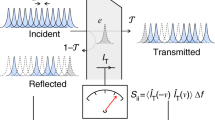Abstract
Fluorescence induced by the tunnelling current of a scanning tunnelling microscope is used to investigate the electromagnetic coupling of a metal tip and a metal sample. Sub-atomic scale modifications of the tunnelling junction geometry cause spectral shifts of the fluorescence. Such shifts are observed when the tip is vertically displaced relative to a flat sample surface. Similarly, monatomic sample steps close to the tip position shift the fluorescence. These experimental results are consistent with model calculations of the electromagnetic response of an appropriate tip-sample geometry. We find that for sharp tips the electromagnetic coupling of the tip and the sample is confined to a lateral range of a few nm.
Access this chapter
Tax calculation will be finalised at checkout
Purchases are for personal use only
Preview
Unable to display preview. Download preview PDF.
Similar content being viewed by others
References
Surface Plasmons, H. Raether (Springer Tracts in Modern Physic 111, Berlin 1988)
Optical properties of Metal Clusters, U. Kreibig and M. Vollmer (Springer Series in Materials Science 25, Berlin 1995).
H.-J. Güntherodt, D. Anselmetti, E. Meyer (Eds.), Forces in Scanning Probe Methods, NATO ASI Series E, Vol. 286 (Kluwer, Dordrecht, 1995).
D. W. Pohl and D. Courjon (eds.), Near Field Optics, NATO ASI Series E, Vol. 241 (Kluwer, Dordrecht, 1993).
J. K. Gimzewski, J. K. Sass, R. R. Schüttler, J. Schott, Europhys. Lett. 8, 435 (1989).
P. Johansson, R. Monreal, S. P. Apell, Phys. Rev. B 42, 9210 (1990).
R. Berndt, J. K. Gimzewski, P. Johansson, Phys. Rev. Lett. 67, 3796 (1991).
B. N. J. Persson and A. Baratoff, Phys. Rev. Lett. 68, 3224 (1992).
M. Tsukada, T. Schimizu, K. Kobayashi, Ultramicroscopy 42–44, 360 (1992).
S. Ushioda, Y. Uehara, M. Kuwahara, Appl. Surf. Sci. 60/61, 448 (1992).
J. Aizpurua, G. Hoffmann, S. P. Apell, R. Berndt, Phys. Rev. Lett. 89, 156803 (2002).
G. Hoffmann, L. Libioulle, R. Berndt, Phys. Rev. B, 65, 212107 (2002).
G. Hoffmann, J. Kroger, R. Berndt, Rev. Sei. Instrum. 73, 305 (2002).
R. Berndt, J. K. Gimzewski, P. Johansson, Phys. Rev. Lett. 71, 3493 (1993).
R. Berndt and J. K. Gimzewski, Phys. Rev. B 48 4746 (1993)
V. Sivel, R. Coratger, F. Ajustron, J. Beauvillain, Phys. Rev. B 50 5628 (1994).
We use ‘counts’ to indicate the number of detected photons while ‘photons’ refers to the estimated number of emitted photons, i.e., the data is corrected for the detection efficiency.
J. Aizpurua, S. P. Apell, R. Berndt, Phys. Rev. B 62, 2065 (2000).
R.W. Rendell, D.J. Scalapino, B. Mühlschlegel, Phys. Rev. Lett. 41, 1746 (1978).
R. Péchou et al, J. Phys. III 6, 1441 (1996).
Handbook of Optical Dielectric Constants of Solids, D. Palik (ed.) (Naval Research Laboratory, Washington D.C., 1985).
K. Stokbro, U. Quaade, F. Grey, Appl. Phys. A: Mater. Sei. Process. 66, S907 (1998).
R. Berndt et al., Science 262, 1425 (1993).
I. I. Smolyaninov, Surf. Sci. 364, 79 (1996).
S. Evoy, F. D. Pardo, P. M. S. John, H. G. Craighead, J. Vac. Sei. Technol. A 15, 1438 (1997).
D. Fujita et al., Surf. Sci. 454–456, 1021 (2000).
G. E. Poirier, Phys. Rev. Lett. 86, 83 (2001).
Author information
Authors and Affiliations
Editor information
Editors and Affiliations
Rights and permissions
Copyright information
© 2003 Springer Science+Business Media Dordrecht
About this chapter
Cite this chapter
Hoffmann, G., Aizpurua, J., Apell, S.P., Berndt, R. (2003). Tunnelling Induced Fluorescence as a Probe of Electromagnetic Interaction at Nanometre Proximity. In: Charra, F., Agranovich, V.M., Kajzar, F. (eds) Organic Nanophotonics. NATO Science Series, vol 100. Springer, Dordrecht. https://doi.org/10.1007/978-94-010-0103-8_8
Download citation
DOI: https://doi.org/10.1007/978-94-010-0103-8_8
Publisher Name: Springer, Dordrecht
Print ISBN: 978-1-4020-1280-8
Online ISBN: 978-94-010-0103-8
eBook Packages: Springer Book Archive




